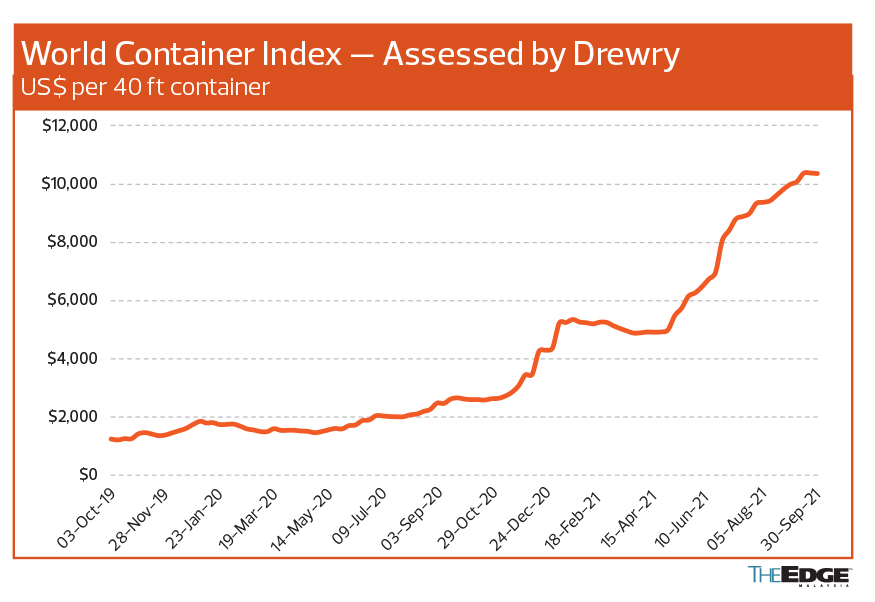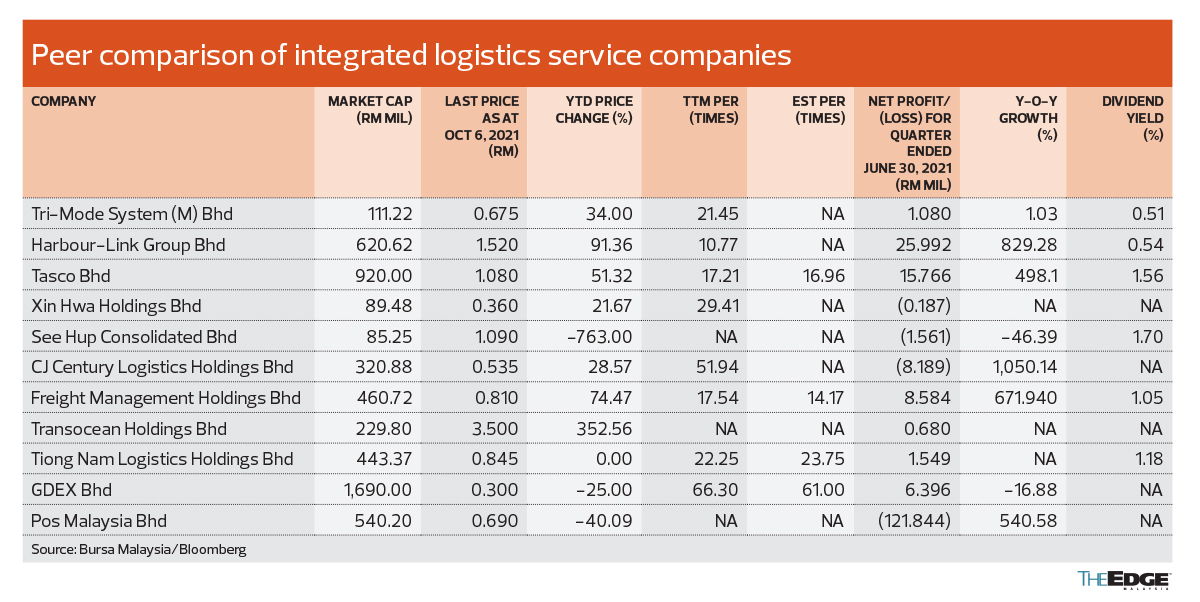Record container rates keep the good times rolling for logistics players
21 Oct 2021
Riding the wave of rising container shipping rates, local integrated logistics service providers have seen year-on-year (y-o-y) improvement in profitability in the past year. Although there have been some reports that shipping costs from China, which have to date held at high levels, have fallen sharply in recent weeks, industry executives are expecting the good times to keep rolling as container freight rates are likely to remain elevated through the first quarter of 2022.
Spot rates for container freight continue to set record highs. The Drewry World Container Index, which measures the cost of shipping a 40-foot-equivalent unit (FEU) container in eight major routes to/from the US, Europe and Asia, has nearly quadrupled from a year ago, to US$10,360.87 as at Sept 30.
On the local front, the Bursa Malaysia transportation and logistics index has risen about 13% year to date, outperforming the FBM KLCI, which has fallen about 4% over the same period.
After two decades of losses, container shipping companies are finally seeing bumper earnings with an unprecedented surge in freight rates, thanks to rising demand for goods and disruption to global supply chains caused by the Covid-19 pandemic. However, the last decade has seen direct beneficiaries like Bursa Malaysia-listed MISC Bhd and Hubline Bhd exiting the loss-making container shipping business.
Freight Management Holdings Bhd group managing director Chew Chong Keat describes the surging container freight rates as a global phenomenon, with freight forwarders, such as his company, an indirect beneficiary.
“Unlike the shipping lines, they are the direct beneficiaries. How it impacts us is in terms of the rates and space availability that we can secure from the shipping lines. As freight forwarders, we bundle these with our other services and offer them to our customers. If we can negotiate good freight rates and space (onboard ships), this will help our business,” he tells The Edge.
Chew notes that while container freight rates have risen sharply, intra-Asia rates have not reached levels seen on routes out of Southeast Asia to the US.
According to London-based Drewry Shipping Consultants Ltd, container rates from Shanghai to Los Angeles nearly tripled in a year to US$12,172 per FEU on Sept 30, while rates on Los Angeles-Shanghai cost US$1,383 per FEU, 167% higher than a year ago.

Chew says Freight Management has seen cargo volumes recover to pre-Covid-19 levels. “This is not just in Malaysia but other countries where the group has a presence,” he adds.
Currently, the group has a presence in Malaysia, Indonesia, Thailand, Vietnam, India, the Philippines, Australia, the United Arab Emirates and the US.
In the financial year ended June 30, 2021 (FY2021), the largest contributor to the group’s revenue was sea freight, followed by air freight, third-party logistics, warehousing and distribution, supporting services and land freight.
Freight Management is projecting growth for FY2022. It posted a 124% y-o-y jump in net profit to RM27.04 million for FY2021, with revenue coming in at RM763.43 million, up 38.4% y-o-y.
“Things look positive going forward, as the World Trade Organization and the International Monetary Fund are predicting (global economic) growth in 2021. Malaysia’s gross domestic product also expanded so far this year due to a low base effect. Moreover, we are finally seeing some stability in the number of Covid-19 cases — still high but it is reducing — and the country’s vaccination rate is ahead of most other Asean countries. All governments, not just Malaysia’s, are also pump priming their economy,” Chew says.
Tasco Bhd is also riding the rise in freight rates. The group posted a 364% jump in net profit to RM41.27 million for the financial year ended March 31, 2021 (FY2021), with revenue of RM946.61 million, up 27% from FY2020. In 1QFY2022, it saw its net profit leap 498% y-o-y to RM15.77 million as revenue climbed 62% to RM290.05 million.
“If you look at our fiscal first-quarter results, we have maintained our growth momentum. Our sales and profits are now higher than pre-pandemic levels,” its deputy group CEO Tan Kim Yong tells The Edge.
Contrary to expectations, he says the sudden surge in shipping demand since the middle of last year caught the group by surprise due to the global rise in demand for electrical and electronic (E&E) products and semiconductors. This bodes well for Tasco due to its exposure to the two markets as well as the food and beverage and pharmaceutical industries.
Tan sees container freight rates remaining high at least until the first quarter of next year amid surging demand for goods, shortage of empty containers and congestion at major ports due to pandemic-related restrictions.
Blank sailings also pose a major challenge for shippers in Malaysia as vessels may skip local ports, intensifying the shortage in capacity, he says. This, in turn, puts upward pressure on the cost of transportation.
“A downward trend of freight rates to pre-pandemic levels is only likely sometime in 2023,” Tan adds.
He believes the longer-term outlook for integrated logistics service providers like Tasco is poised to brighten even after rates return to pre-pandemic levels as the economy recovers. “Logistics is a business that thrives on economic activity and international trade, so we believe that we will benefit from a post-pandemic economic revival.”
Meanwhile, Xin Hwa Holdings Bhd managing director Ng Aik Chuan says signs of gradual recovery have been apparent in its land transportation services segment due to measured resumption of economic activities on the local front. In a Sept 30 statement, he pointed to the government’s forecast of 7.5% growth for the transportation and storage services sector in 2021.

Surge in warehouse space demand another boon for logistics firms
Tasco’s freight forwarding segment is not the only business that is leveraging the higher-than-usual rates. An increase in warehousing business for electrical and electronic products, musical instruments, solar panels and fast-moving consumer goods had pushed the group’s warehouse division to report a 5.8% y-o-y increase in revenue to RM1.9 million for 1QFY2022.
According to Tan, rates for warehousing space have risen by about 20%, especially in the country’s central region.
“There is currently a shortage of warehousing space that has caused the rates to rise. There are a few reasons for this. Previously, companies used just-in-time, or JIT, inventory. But with the pandemic bringing uncertainty to the supply chain, companies are looking to keep more inventories on hand to guard against shortages of raw materials which, in turn, will affect their (production) lines.
“Also, the ongoing US-China trade war is causing a global semiconductor shortage (which has impacted the production of a range of products, from cars to computers). As a result, some firms are keeping extra inventory to avoid disruption to their assembly lines,” he explains.
Logistics providers and industrial/warehouse real estate investment trusts with their own warehousing capacity stand to gain from the rise in demand for warehouse space. In fact, Tasco has allocated RM400 million to RM500 million for capital expenditure over the next five years, with the bulk of spending earmarked for warehouse expansion in Shah Alam, Selangor.
Xin Hwa’s Ng, in his statement, noted that the surge in online shopping due to the pandemic has escalated the need for warehousing space as the shipping container crunch caused a slowdown in the movement of cargoes, resulting in goods being kept longer in warehouses, exacerbating the shortage of warehousing space. The group sees the utilisation rate of its warehouses picking up strongly in the next 12 months.
Its new fulfilment centre is targeted to commence operations by this month and will add another 300,000 sq ft or 45.8%, bringing the group’s total available warehousing space to approximately one million sq ft.
Xin Hwa is in the midst of unlocking the value of two pieces of industrial land totalling 6.56ha in Pasir Gudang by selling them to Axis Real Estate Investment Trust for RM75 million. With an enlarged war chest, the group is currently on the lookout for merger and acquisition opportunities that would be earnings accretive to the group.
Xin Hwa slipped into the red in the fiscal first quarter ended June 30, 2021 (1QFY2022), with a net loss of RM187,000 compared to a net profit of RM12,000 due to higher provision of income tax and deferred tax expenses. Warehousing and distribution operations accounted for 13.5% of the group’s total revenue of RM23.1 million for 1QFY2022.
Intense price war a drag on local express delivery players
The scenario is a contrasting one for local express delivery providers. While DHL Express and FedEx Corp are raising their parcel rates next year, their local counterparts are facing increasing competition with the entry of a new generation of logistics start-ups such as Ninja Van, Lalamove and J&T Express, which has sparked a price war.
GDEX Bhd managing director and group CEO Teong Teck Lean says local express delivery providers like GDEX are not raising their rates in the domestic market in response to their international counterparts. Prices for international trade lanes have so far increased by 5% to 10% compared to last year.
“We don’t want to compete (on price and bring down our rates to) these super low levels. For example, some of these e-commerce platforms, in order to get volume, provide free delivery for maybe a week. They are basically losing money. That is very unhealthy. If we have to sacrifice on price, then our quality will be impacted. As such, we would rather focus on the user experience — how to provide end-to-end solutions to our customers so that they will continue to stay with us,” he tells The Edge.
“That’s also why we could generate consistent earnings growth despite the stiff competition. If we just want the volume, then we could go into losses if we are not careful. So the important thing is to continue to make our service more relevant to be in the game. At the same time, we will look at expediting the digitalisation of our operational processes and be more cost-effective to transform ourselves into a digital and technology company. Hence, the change in name to GDEX (from GD Express Carrier) in December last year,” he says.
GDEX managed to post a 41% jump in net profit to RM26.09 million for the 12 months to June 30, 2021, on the back of an 18% y-o-y increase in revenue to RM430.51 million, which Teong attributes to operational cost efficiencies as a result of digitalisation work on internal systems and processes. The group has changed its financial year end from June 30 to Dec 31.
Meanwhile, the group is looking to double its warehousing capacity by signing a 15-year lease agreement with Sapura Resources Bhd recently. “We will look at growing our volume again over the next one year,” Teong says, noting that the group’s volumes are almost back to pre-pandemic levels.
He says the group will also continue to pursue inorganic growth. “We are looking for strategic investments that allow us to accelerate our growth and expand our business streams, and complete our regional expansion. Right now, the growth is not at the level that we want.”
GDEX’s cash balance stood at RM48.37 million at end-June 2021, while borrowings totalled RM20.62 million.
Source: The Edge Markets


